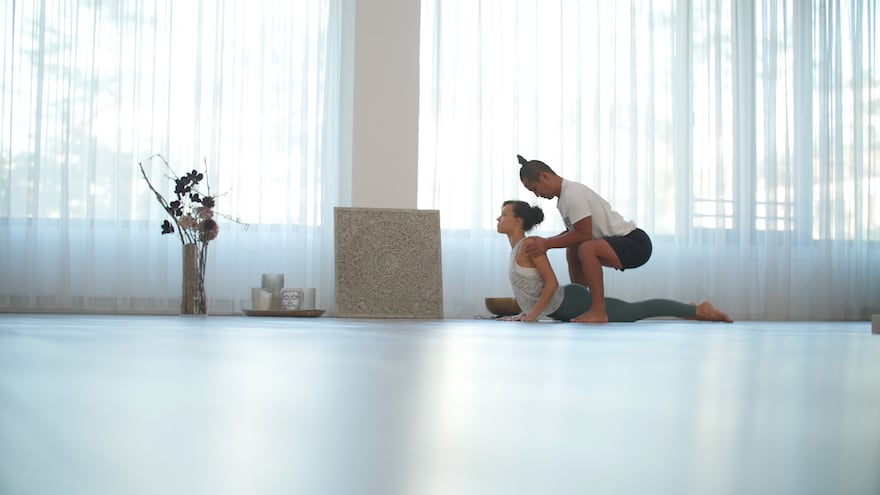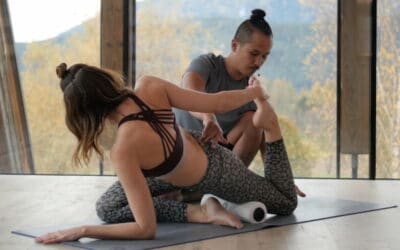Let’s face it: Forward folds and backbends are big in yoga. You don’t have to attend many yoga classes to see fellow yogis pretzeling into a Standing Forward Fold (Uttanasana) and putting their nose between the knees.
Or you may have the impression that everyone in your yoga class is able to relax their trunk onto their legs in a Seated Forward Bend (Paschimottanasana) – everyone, except for: you. And then, there is the yogi next to you, bending the spine like Bendy Wendy in Cobra (Bhujangasana). So, you may have decided to face the truth and surrender: You simply have tight muscles. Period.
However, it is important to understand that bending forward and backward is not a question of flexibility only. Range of motion in the joints involved also plays a crucial role. While struggling with getting into deeper forward folds and deeper backbends can certainly be due to tight hamstrings or other muscles, the underlying cause may also be a completely different one: a joint lock created by full extension of the knees or elbows, limiting your range of motion.
While muscles take time to become more flexible, here is one single cue for you that will help you get deeper into your poses immediately by increasing your range of motion.
Table of Contents
1. The Secret to Deepening Your Forward Folds
Forward folds, such as Uttanasana (Standing Forward Fold), stretch the entire back of your body, from the upper and lower spine to the hips and the legs. Since most of us are sitting all day long, this is a great way to reset your body and lengthen the hamstrings instead of keeping them short.
But forward folds aren’t just beneficial to your muscles and joints, they also massage the abdominal organs and help to improve digestion. Apart from that, they can help to calm the central nervous system, relieve stress and reduce fatigue, headaches and insomnia.
However, while some of you may experience forward folds as very challenging poses, putting a lot of stress on your lower back and the backs of your legs, they can help you relieve tension in the lower back when practiced appropriately.
1.1. What Actually Prevents You From Deepening Your Forward Folds
The limiting factor that prevents you from experiencing deeper forward folds is the hip flexor area or rather one particular hip flexor muscle: the rectus femoris. The rectus femoris muscle forms part of the hip flexors and the quadriceps.
It originates close to the anterior hip capsule, i.e. at the anterior inferior iliac spine (AIIS) and the anterior part of the acetabulum, to be precise. The acetabulum is the cup-shaped part of the hip bone where the thighbone (femur) meets the hip. Together, these two bones form the hip joint. The insertion of the rectus femoris is at the head of the shinbone (tibia), together with the other quadriceps muscles.
Thus, the rectus femoris is the only quadriceps muscle that traverses both the hip and the knee. This is why this powerful hip flexor muscle is not only dependent on the position of the hip but also of the knee to assert its influence: It is most powerful when the knee is flexed, whereas it significantly loses power if the knee is extended, i.e. locked.
Fully extending the knee thus creates a joint lock in the pelvis, preventing you from using the full range of motion of the pelvis. Consequently, this will limit your mobility and prevent you from getting into a deeper forward fold and experiencing the full advantage of poses such as Uttanasana. See what difference it makes to bend the knees instead of keeping them straight:

Keeping your knees bent in Uttanasana will give you more space for a deeper Forward Fold.
1.2. One Thing That Helps You With Deeper Forward Folds
So, how can you apply this knowledge to get deeper into your Standing Forward Fold, for example? To answer this question, we first need to take a look at what happens in your pelvis area and lumbar spine when performing Uttanasana: The weight of your upper body and spine pulls the sacrum in the direction of the load, i.e. forward and down.
This means that if you have tight hamstrings and keep the knees straight (and locked) when bending forward in Uttanasana, the hamstrings pull the pelvis down like a rope. Consequently, most of the flexion in your pelvis comes from the lumbar spine.
If, on the other hand, the knees are bent, the pelvis can tilt forward, allowing to bend forward from the hip joint, rather than from the lumbar spine because the hamstrings do not pull the pelvis down and it is free tip forward and follow the movement of the sacrum. As a result, the sacrum and the pelvis are able to move in the same direction. This will put less stress on the muscles and ligaments surrounding them.
This interaction of how the pelvis and lumbar spine move in relation to each other is known as spino-pelvic rhythm. Ideally, a forward fold should predominantly come from pelvic movement (pelvic dominance) rather than from the lumbar spine (lumbar dominance).

Forward folds are a part of almost every yoga class. Photograph by Dane Wetton on Unsplash.
Being aware of the spino-pelvic rhythm helps you to understand why you can increase the range of motion of your hip and pelvis by keeping the knees bent first when you go into Uttanasana and, thus, experiencing deeper forward folds.
Bring the pelvis in the desired position by letting the sacrum sink deeper into the back of your pelvis and bringing the tailbone closer to the pubic bone before you start straightening your knees. Avoid locking them back by pressing your hands against the back of each knee to provide some resistance. Provided that you have tight hamstrings, this will take a lot of tension off your hamstrings.
Getting into deeper forward folds is no longer a question of flexibility, but rather of the correct technique. Since a proper and healthy technique is essential to any yoga pose, we have compiled an ebook summarizing the basic yoga alignment principles to make your yoga practice safe and efficient.
2. How to Practice Deeper Backbends With Ease
Now that you have found a way to getting more benefits from your forward folds, you may want to experience the same in back-bending poses. The good news is: You don’t need magic to achieve this, but a good understanding of the anatomy of your shoulders and elbows.
However, your first question may be whether you have to incorporate deeper backbends into your yoga practice. The answer is simple: you don’t havetobut backbends are great for stretching the front of the torso, the arms and the shoulders. They help you to increase the flexibility of your spine and to reduce back pain. So deeper backbends can be really beneficial – under certain conditions, though.
They can also causeback pain if performed the wrong way and compressing the lower back. This happens in particular if the shoulders are not moving back. However, you may have the impression that you don’t have any range of motion to move the shoulders back at all in Cobra, for example. The reason here, again, is a joint lock. This time, the joint lock that prevents you from enjoying deeper backbends is in the shoulder due to full extension of the elbow.
2.1. Why Deeper Backbends Are Not a Matter of Flexibility
Basically, the same principle that prevents you from experiencing deeper forward folds applies here: Fully extending the elbow causes a joint lock in the shoulder, which eventually limits your ability to get into a deeper backbend in Bhujangasana, for example.
Examine this with the arms fully extended in front of you: The range of motion in your shoulders is limited. However, if the elbows are bent, the range of motion increases. Do you feel the difference? The reason for this is quite similar to the reason why the range of motion in your pelvis increases when you bend your knees.
The muscles responsible for flexion of the elbow form the flexor group and include the brachialis, biceps brachii, and the brachioradialis. These muscles bend the arm by decreasing the angle between the forearm and upper arm. The long biceps brachii muscle runs anterior to the upper arm bone (humerus) from the shoulder blade (scapula) to the radius, which is one of the two lower arm bones. This means that it traverses the shoulder and the elbow joint and limits shoulder mobility when the elbow is completely extended.

Check out our Inside Yoga Alignment program to learn how to practice deeper backbends. Photograph by TINT.
This is why you should keep the elbows bent when you move into Bhujangasana in order to move your shoulders further up and back. So, when you go into Cobra, start with bent elbows and draw the upper arm bone back into the shoulder socket. Then straighten your arms. This will immediately give you more range of motion and let you experience a deeper backbend.
2.2. Deeper Backbends Without Compressing Your Spine
Even though your focus may be on deeper backbends, your first priority should be avoiding compression in the lower back. Unlocking your shoulder joint by bending your elbow helps you with this issue as well.
If you fully extend – or even hyperextend – the elbows in Bhujangasana, for example, the force created by the hands pushing into the mat will be directed towards your lower back, which you want to avoid. Ideally, the force is directed through the long axes of the forearm, the upper arm and the shoulders and only then through to the trunk and pelvis. In addition to slightly bending the elbows, this can be achieved by putting the hands underneath the shoulders so that the forearms are in a vertical line instead of placing your hands further towards the front of the mat.
But what is the ultimate way to decompressing your spine? Pushing your upper trunk up using the techniques described above, and pushing your lower body down. However, you may have the impression that tight hip flexors restrict the movement of the pelvis and in that way create a feeling of compression in the lower back as you move into Cobra, for example.
You need more range of motion in your hip to push the lower part away. How can you do that? Correct! By bending your knees. In Cobra, this means lifting your buttocks up and pulling your knees further towards you. Then, pull the pubic bone towards your navel and suck the navel in. This will engage your core muscles and, thus, protect you lower back to guide you safely into a deeper backbend.
If this is too much information to digest at once, you can either re-read these alignment tips later or simply download our ebook on yoga alignment secrets as a quick reference guide.
3. Why the Struggle With Flexibility Is Over
The thing is that locked joints impact your range of motion in almost every asana. Try to think of any yoga pose where you don’t need the range of motion of your pelvis or shoulders. Apart from Savasana – where you don’t move at all – there probably won’t be many poses coming to your mind.
Joint locks do not only prevent you from going into a deeper forward fold in Uttanasana or a deeper backbend in Bhujangasana, but you also risk putting too much stress on your hip and shoulder joints and the muscles surrounding them if you try to overcome the lack of range of motion by over-stretching the muscles, i.e. by pulling yourself into Uttanasana or pushing yourself too far up into Cobra.
Apart from that, locking your joints may even result in hyperextension. Hyperextending a joint while it is supporting your body weight is not only dangerous for the joint, but can also damage ligaments, cartilage and other structures that stabilize the joint. Over time, repeated hyperextension can lead to pain and injury – and ultimately even to surgery.
You can avoid hyperextension by engaging the muscles around the joint. This will protect the joint by spreading the weight to your muscles instead of all the work of holding you up being done by your knee or elbow, for example. This is because the muscles that support your joints are now able to work in ways that are impossible when you hyperextend.
So, this is how unlocking your joints in your yoga practice will give you more range of motion and, as a result, enable you to enjoy deeper forward folds and deeper backbends.
If you have constantly been struggling with flexibility in your previous yoga classes, this will instantly make a big difference to your practice by improving your shoulder and hip mobility. And who knows? Soon you will feel like Bendy Wendy in your yoga class.
4. How to Dive Deeper (Into the Topic)
If you’re interested in learning more about this and other common alignment issues, have a look at out our Inside Yoga Alignment program, which takes you step by step through some of the most essential yoga poses, clarifying a number of widespread misconceptions about yoga alignment. There is a whole section on backbends, including Bhujangasana, so you can deepen not only your bends but also your knowledge about various poses – more than one AHA! effect promised!
Deepen your knowledge with the Inside Yoga Alignment plan on TINT.





